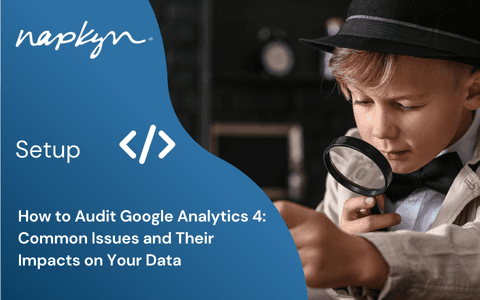

November 2023 GA4 & Google Updates
Napkyn's Monthly Update on all things GA4 - The things you need to know.

Monika Boldak
Associate Director, Data Solutions
Looker Studio Updates
In November Looker Studio expanded its functionality with exciting features.
Personal Looker Studio reports are designed to be ephemeral, meaning you don’t need to worry about creating unwanted content, but if you land on valuable insights that you want to keep, you can save and share these reports with new links, separate from the original report you built from. Whether you share a report link in group chats or direct messages, an individual copy is created for each user that opens it so that everyone gets their own personal report.
Looker Studio users can now enable their reports to auto-refresh data at a predefined cadence, so critical business decisions are based on current and updated information.
Quick Filters were added just below the top bar in each report. Quick filters enable powerful exploration to slice data and uncover hidden patterns and insights within the context of your report. Quick filters don’t affect other users’ views, so whether you are exploring in a shared or personal report, your unique view is only shared once you are ready. The filter bar also gives you a complete picture of whether applied filters originate from interactive cross-chart filtering or quick filters.
Google has added the ability to pause updates, giving users the flexibility to fully configure chart elements like fields, filters, parameters, sorting, and calculated formulas before running any data updates. Users can then simply resume updates to see the updated data. Pausing updates does not prevent any style changes, so users can continue to modify design elements and other detailed styles and formatting without running a single query.
Sampling in Standard Reports
Sampling has now been introduced into GA4 standard reports. Previously, all standard reports were fully unsampled. This is no longer always the case. It is affecting Standard Reports in Standard and 360 properties with a high number of values and it has been noticed in Pages and Screens Report only so far but may start affecting other reports soon.

Additionally, cardinality has been applied to Exploration reports as well.

Google's Consent Mode
Google's Consent Mode will become mandatory from March 2024 and those who do not use it will not register new European users in Google Ads & GA4 Audiences from then on.
Also part of this change: in the future there will be a "Basic Mode" and an "Advanced Mode".
Basic Mode does what you'd expect from a feature called Consent Mode and completely prevents data collection if the user's consent status is set to "denied" for Google tracking.
Disadvantage: Due to a lack of data, Google has to guess the number of users without consent, which means that the final modeled data is correspondingly inaccurate.
The Advanced Mode works like the Consent Mode so far: no cookies are set, but the Google Tag sends "pings" to at least capture the number of users who do not give consent.
With normal client-side tracking, this makes little sense, because other personal data such as the IP address or the user-agent are still transmitted, even without cookies.
Google's tip: Use server-side tagging to really anonymize these consent pings.
Chrome Extension
Tag Assistant Legacy Chrome Extension will not get any further updates or support from Google.
Google is now recommending Tag Assistant Companion.me Extension
Improvements to data sampling and the (other) row
Google Analytics stores data from your website or app in two types of tables optimized for either performance or flexibility. With this update, Google Analytics now chooses the table that provides the most accurate results for each query, reducing the likelihood of seeing the (other) row and data sampling in reports and explorations.
As a result, you may now see the (other) row in explorations or data sampling in reports because Analytics chooses the table based on your query to provide the most accurate results and reduce the impact of data sampling and cardinality limits.
Learn more about how data is stored and displayed.
Scheduled emails
As an administrator, you can now schedule standard and custom reports to be sent by email on a regular basis, enabling team members to receive periodic updates about your reports. The emailed report includes data for the specified date range with any filters or comparisons applied to the report when the email was first scheduled.
Learn more about scheduled emails.
Increased Parameter Value Character Limit for GA4 360 Customers
Analytics 360 customers with Google Analytics 4 properties can now send string parameter values of up to 500 characters from web data streams.
Previously, Analytics 360 GA4 properties would truncate string parameter values from web data streams that exceed the 100 character limit. Now, web data streams can collect string parameter values up to 500 characters, giving you greater flexibility to collect URL and UTM combinations, campaign names, product bundle names, and other custom and predefined values.
Standard properties are not affected by this update and will continue to adhere to the current limits.
Learn more about the Analytics 360 feature limits.
Integrate Salesforce Marketing Cloud with Google Analytics 4
You can now integrate Salesforce Marketing Cloud with a Google Analytics 4 property from the Sales Marketing Cloud interface. If you were using the Universal Analytics 360 integration with Salesforce Marketing Cloud, you can now use the same functionalities in Google Analytics 4.
For the first time, the integration is available to both Google Analytics 4 standard and 360 properties. Today, the experience is live in Salesforce Marketing Cloud for anyone who was using the integration with Universal Analytics 360.
The Google Analytics 4 integration with Salesforce Marketing Cloud lets you synchronize audiences created in Analytics to Marketing Cloud, and use those audiences in your Salesforce email and SMS direct-marketing campaigns.
To learn more about the Sales Marketing Cloud integration, see Salesforce Marketing Cloud audience integration.
More Insights


Ready for What? AI Readiness in Marketing Today

Jasmine Libert
Senior Vice President, Data Solutions
Apr 30, 2025
Read More


BigQuery for Marketers: Combine GA4, Google Ads & CRM Data for Smarter Decision

Shreya Banker
Data Scientist
Apr 23, 2025
Read More


How to Audit Google Analytics 4 (GA4): Common Issues and Their Impacts on Your Data

Hasan Alanam
Manager, Data Solutions
Apr 7, 2025
Read More
More Insights
Sign Up For Our Newsletter

Napkyn Inc.
204-78 George Street, Ottawa, Ontario, K1N 5W1, Canada
Napkyn US
6 East 32nd Street, 9th Floor, New York, NY 10016, USA
212-247-0800 | info@napkyn.com

November 2023 GA4 & Google Updates
Napkyn's Monthly Update on all things GA4 - The things you need to know.

Monika Boldak
Associate Director, Data Solutions
Looker Studio Updates
In November Looker Studio expanded its functionality with exciting features.
Personal Looker Studio reports are designed to be ephemeral, meaning you don’t need to worry about creating unwanted content, but if you land on valuable insights that you want to keep, you can save and share these reports with new links, separate from the original report you built from. Whether you share a report link in group chats or direct messages, an individual copy is created for each user that opens it so that everyone gets their own personal report.
Looker Studio users can now enable their reports to auto-refresh data at a predefined cadence, so critical business decisions are based on current and updated information.
Quick Filters were added just below the top bar in each report. Quick filters enable powerful exploration to slice data and uncover hidden patterns and insights within the context of your report. Quick filters don’t affect other users’ views, so whether you are exploring in a shared or personal report, your unique view is only shared once you are ready. The filter bar also gives you a complete picture of whether applied filters originate from interactive cross-chart filtering or quick filters.
Google has added the ability to pause updates, giving users the flexibility to fully configure chart elements like fields, filters, parameters, sorting, and calculated formulas before running any data updates. Users can then simply resume updates to see the updated data. Pausing updates does not prevent any style changes, so users can continue to modify design elements and other detailed styles and formatting without running a single query.
Sampling in Standard Reports
Sampling has now been introduced into GA4 standard reports. Previously, all standard reports were fully unsampled. This is no longer always the case. It is affecting Standard Reports in Standard and 360 properties with a high number of values and it has been noticed in Pages and Screens Report only so far but may start affecting other reports soon.

Additionally, cardinality has been applied to Exploration reports as well.

Google's Consent Mode
Google's Consent Mode will become mandatory from March 2024 and those who do not use it will not register new European users in Google Ads & GA4 Audiences from then on.
Also part of this change: in the future there will be a "Basic Mode" and an "Advanced Mode".
Basic Mode does what you'd expect from a feature called Consent Mode and completely prevents data collection if the user's consent status is set to "denied" for Google tracking.
Disadvantage: Due to a lack of data, Google has to guess the number of users without consent, which means that the final modeled data is correspondingly inaccurate.
The Advanced Mode works like the Consent Mode so far: no cookies are set, but the Google Tag sends "pings" to at least capture the number of users who do not give consent.
With normal client-side tracking, this makes little sense, because other personal data such as the IP address or the user-agent are still transmitted, even without cookies.
Google's tip: Use server-side tagging to really anonymize these consent pings.
Chrome Extension
Tag Assistant Legacy Chrome Extension will not get any further updates or support from Google.
Google is now recommending Tag Assistant Companion.me Extension
Improvements to data sampling and the (other) row
Google Analytics stores data from your website or app in two types of tables optimized for either performance or flexibility. With this update, Google Analytics now chooses the table that provides the most accurate results for each query, reducing the likelihood of seeing the (other) row and data sampling in reports and explorations.
As a result, you may now see the (other) row in explorations or data sampling in reports because Analytics chooses the table based on your query to provide the most accurate results and reduce the impact of data sampling and cardinality limits.
Learn more about how data is stored and displayed.
Scheduled emails
As an administrator, you can now schedule standard and custom reports to be sent by email on a regular basis, enabling team members to receive periodic updates about your reports. The emailed report includes data for the specified date range with any filters or comparisons applied to the report when the email was first scheduled.
Learn more about scheduled emails.
Increased Parameter Value Character Limit for GA4 360 Customers
Analytics 360 customers with Google Analytics 4 properties can now send string parameter values of up to 500 characters from web data streams.
Previously, Analytics 360 GA4 properties would truncate string parameter values from web data streams that exceed the 100 character limit. Now, web data streams can collect string parameter values up to 500 characters, giving you greater flexibility to collect URL and UTM combinations, campaign names, product bundle names, and other custom and predefined values.
Standard properties are not affected by this update and will continue to adhere to the current limits.
Learn more about the Analytics 360 feature limits.
Integrate Salesforce Marketing Cloud with Google Analytics 4
You can now integrate Salesforce Marketing Cloud with a Google Analytics 4 property from the Sales Marketing Cloud interface. If you were using the Universal Analytics 360 integration with Salesforce Marketing Cloud, you can now use the same functionalities in Google Analytics 4.
For the first time, the integration is available to both Google Analytics 4 standard and 360 properties. Today, the experience is live in Salesforce Marketing Cloud for anyone who was using the integration with Universal Analytics 360.
The Google Analytics 4 integration with Salesforce Marketing Cloud lets you synchronize audiences created in Analytics to Marketing Cloud, and use those audiences in your Salesforce email and SMS direct-marketing campaigns.
To learn more about the Sales Marketing Cloud integration, see Salesforce Marketing Cloud audience integration.
More Insights

Ready for What? AI Readiness in Marketing Today

Jasmine Libert
Senior Vice President, Data Solutions
Apr 30, 2025
Read More

BigQuery for Marketers: Combine GA4, Google Ads & CRM Data for Smarter Decision

Shreya Banker
Data Scientist
Apr 23, 2025
Read More

How to Set Up GA4 Ecommerce Tracking (Without Data Loss) | A Complete Step-by-Step Guide

Ricardo Cristofolini
Senior Implementation Specialist, Data Solutions
Apr 16, 2025
Read More
More Insights
Sign Up For Our Newsletter


